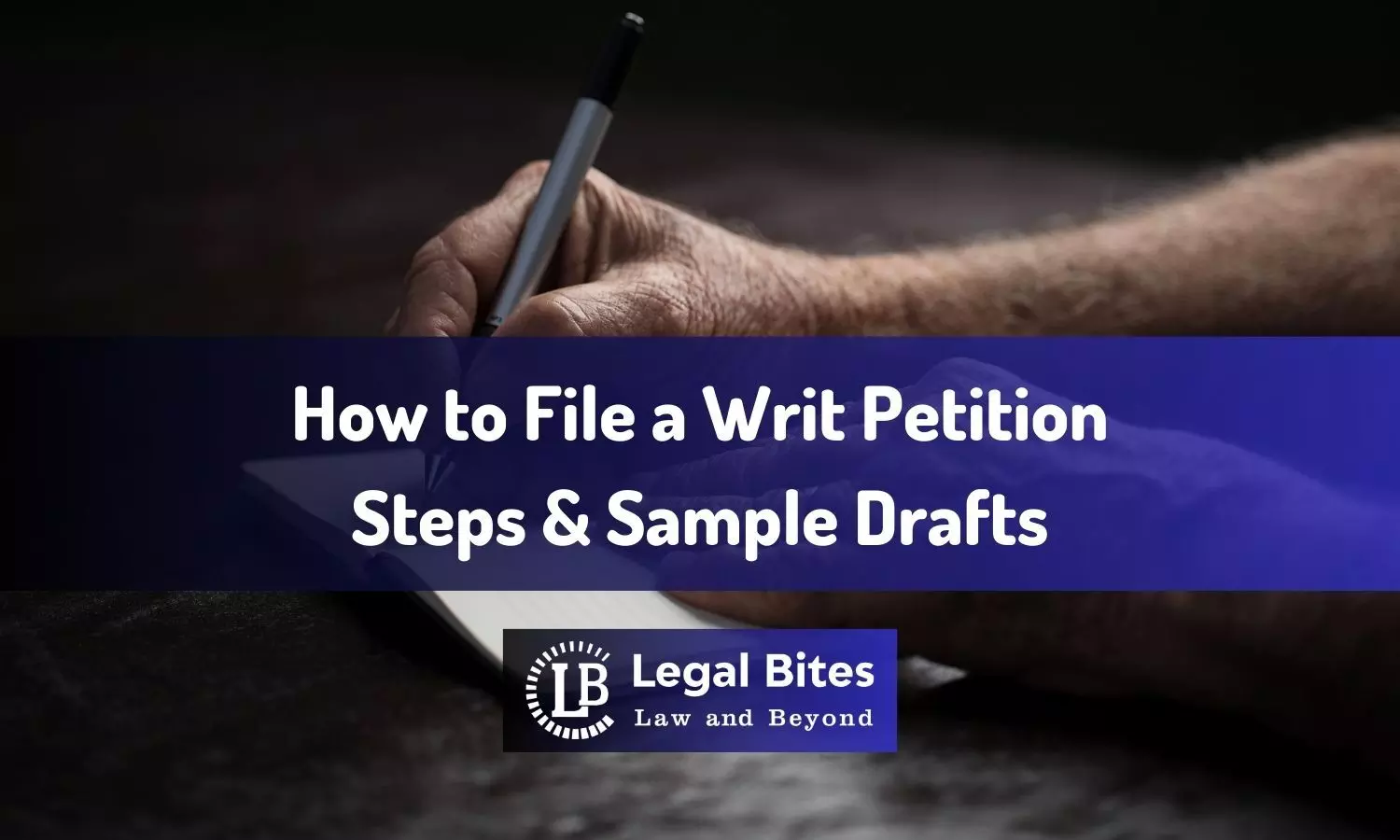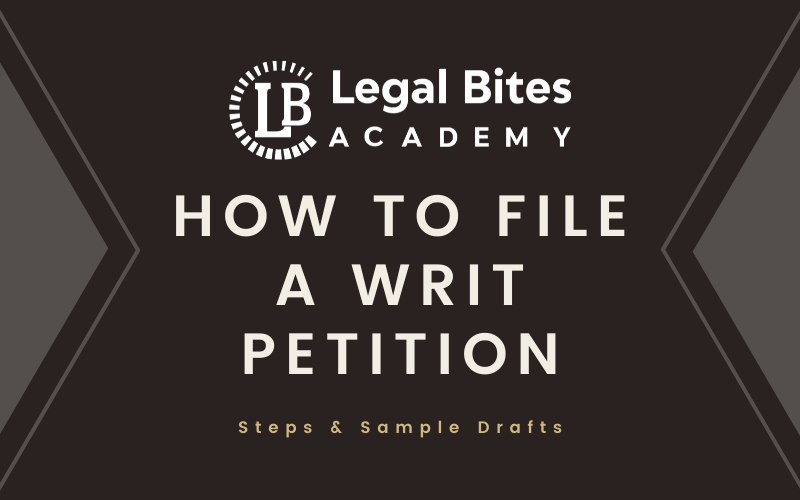How to File a Writ Petition: Steps & Sample Drafts
Learn how to file a Writ Petition with easy steps and sample drafts. Your guide to effective legal action.
This article titled ‘How to file a writ petition: Step & Sample Drafts’ enumerates the process of filing a writ petition from scratch. Not only it gives you the generic answer to the question inbuilt but it also provides you with the legal knowledge in the context of which writ can be filed in which situations and how these different types serve the concept of safeguarding fundamental rights and duties vested in the constitution. As you read along the lines in the article, it becomes an exhaustive resource and a ‘know-it-all’ guide for writ petitions as endowed in the Indian Legal System.
I. What is a writ?
A writ is a legal document that contains an order issued by a certain authority. As a result, a writ may be thought of as a court’s official order. A writ petition is an application made in a court requesting for a particular writ to be issued.
II. What are the types of writs?
The people of India have five kinds of writs under Article 32 and Article 226 of the Indian Constitution. Alternatively, you may hire an experienced lawyer to prepare a writ petition for you at any moment. Depending on the situation, you may also file a criminal or civil writ petition in the High Court or the Supreme Court. If the High Court does not provide a favourable decision, you may file a writ petition with the Supreme Court. The definitions and applicability of these writs vary, as specified below:
1. Habeas Corpus
Habeas corpus is a legal phrase that means “you may have the body of.” When a person is wrongfully imprisoned, this writ may be utilised. The court uses this writ to order that the person who has been detained be brought before the court to have the legitimacy of his imprisonment examined.
In the following situations, a petition of habeas corpus may be filed:
- When a person is arrested but does not appear in front of a magistrate within 24 hours after their arrest, excluding travel time.
- When a person gets arrested despite the fact that he has broken no laws.
- When a person is apprehended with the intent to commit a crime.
In the following situations, a petition of habeas corpus cannot be filed:
- When the person or authority who is the subject of a writ of habeas corpus does not reside within the court’s geographical jurisdiction.
- When a person is detained in line with the law.
The Supreme Court extended the scope of habeas corpus in the case of Sunil Batra versus Delhi Administration, 1980, to include inmates who were subjected to cruel treatment by jail officials. In this instance, the court was found to have the authority and duty to protect the inmates from this heinous behaviour, and that it may utilise the habeas corpus writ to impose jail humanism.
2. Mandamus
Mandamus is a Latin word for “we command.” It is usually a court order given to a public worker, instructing him to fulfil his duties, which he has failed to do. For the same reason, a writ of mandamus may be issued against a corporation, an inferior court, or a government entity that has failed to fulfil its official responsibilities.
A writ of mandamus cannot be filed in the following circumstances:
- The President of India and the Governor of State are not subject to the writ of mandamus.
- The President and the Governor of State are not required to appear in court for the execution of their official responsibilities under Article 361 of the Indian Constitution.
- A writ of mandamus cannot be issued against judges of the High Court and Supreme Court for failing to carry out their judicial responsibilities.
- A private person or private organisation cannot be served with a writ of mandamus.
3. Certiorari
The word certiorari literally means “certified or informed.” It is usually given by a higher court to a subordinate court to either transfer a pending matter to a higher authority or to overturn a previously issued judgment. The Supreme Court decided in 1991 that a writ of certiorari may be granted against administrative bodies if their decisions infringe on an individual’s rights.
The court ruled in Hari Vishnu v. Ahmed Ishaque, 1995, that a manifest mistake in the judgement or determination itself may be subject to a writ of “certiorari” if it is evident on the face of the proceedings.
The following criteria must be met before a writ of certiorari may be issued:
- A court that has the power or legal right to act judicially is required.
- If a lower court’s decision is in violation of the Constitution’s laws.
- If a lower court’s decision includes a mistake.
4. Prohibition
The word prohibition literally means “to forbid.” Only judicial and quasi-judicial authorities may be served with a prohibition writ. Generally, this writ is not applicable against administrative bodies or private persons. It may be issued by a superior court against a lower court or by a lower court to prohibit conduct done outside of the court’s jurisdiction at any point throughout the proceedings.
5. Quo- Warranto
The word quo- warranto refers to the authority or warrant used to make a decision. It is usually issued by a court to inquire about the legitimacy of his position or the authority he has to hold it. It prohibits anybody from holding a public position illegally.
A quo warranto writ cannot be issued against:
- It cannot be used against a minister in order to remove him from office.
- It cannot be used against a state’s chief minister for failing to fulfil his constitutional obligations.
- In the event of a governmental or private office, this writ cannot be issued.
III. How to file the writ petition? (Step by Step)
Step 1: To begin, the offended party must provide essential papers such as evidence of identification, proof of residence, photos, and so on to a certain legal organization or an independent practitioner.
Step 2: The petition is then written with the assistance of a lawyer. The draft contains the offended party’s name and address, as well as the circumstances that led to the infringement of his or her basic rights. Clearly mention the ‘prayers’ or the relief being sought from the court.
Step 3: The court will then schedule a hearing date, at which time it will accept the petition and send a notice to the opposing party.
Step 4: Following that, a date is set to ensure that both parties are present.
Step 5: Finally, after hearing both sides, the court renders a decision and provides relief.
IV. Sample Drafts
Click here to download the sample draft of Writ of Mandamus
Click here to download the sample draft of Writ of Prohibition
Click here to download the sample draft of Writ of Quo-warranto
Click here to download the sample draft of Writ of Certiorari
Click here to download the sample draft of Writ of Habeas corpus




